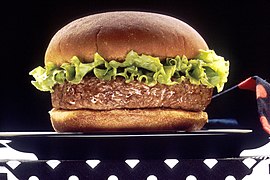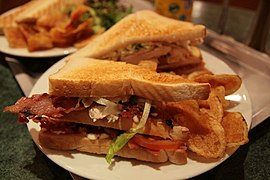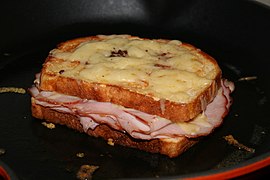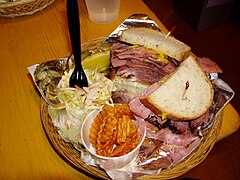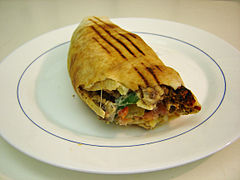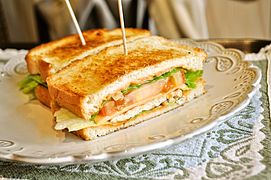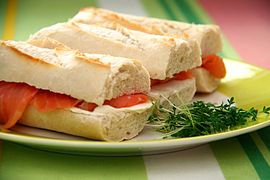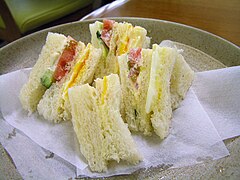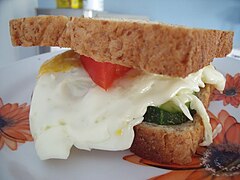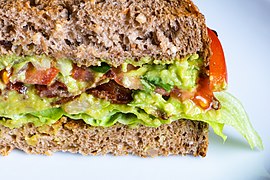Sandwich
A sandwich is a food typically consisting of vegetables, sliced cheese or meat, placed on or between slices of bread, or more generally any dish wherein bread serves as a container or wrapper for another food type.[1][2][3] The sandwich began as a portable, convenient finger food in the Western world, though over time it has become prevalent worldwide.
In the 21st century there has been considerable debate over the precise definition of sandwich, and specifically whether a
Sandwiches are a popular type of lunch food, taken to work, school, or
The sandwich is named after its supposed inventor, John Montagu, 4th Earl of Sandwich.[8][9] The Wall Street Journal has described it as Britain's "biggest contribution to gastronomy".[10]
History
The modern concept of a sandwich using slices of bread as found within the West can arguably be traced to 18th-century Europe. However, the use of some kind of bread or bread-like substance to lie under (or under and over) some other food, or used to scoop up and enclose or wrap some other type of food, long predates the eighteenth century, and is found in numerous much older cultures worldwide.
The ancient Jewish sage
During the
Initially perceived as food that men shared while gaming and drinking at night, the sandwich slowly began appearing in polite society as a late-night meal among the
An alternative is provided by Sandwich's biographer,
The sandwich's popularity in Spain and England increased dramatically during the nineteenth century, when the rise of industrial society and the working classes made fast, portable, and inexpensive meals essential.[16] In London, for example, at least seventy street vendors were selling ham sandwiches by 1850; during that decade sandwich bars also became an important form of eating establishment in western Holland, typically serving liver and salt beef sandwiches.[17]
In the US, the sandwich was first promoted as an elaborate meal at supper. By the early 20th century, as bread became a staple of the American diet, the sandwich became the same kind of popular, quick meal as was already widespread in the Mediterranean.[16]
Language
According to the story, following the Earl of Sandwich's request for beef between two slices of bread, his friends began to order "the same as Sandwich".[9] The first written usage of the English word appeared in Edward Gibbon's journal, in longhand, referring to "bits of cold meat" as a "Sandwich".[18]
Before being known as sandwiches, this food combination seems to have been known as "bread and meat" or "bread and cheese".[8] These two phrases are found throughout English drama from the 16th and 17th centuries.[8]
In the US, a court in Boston, Massachusetts, ruled in 2006 that a sandwich includes at least two slices of bread
In Spain, where the word sandwich is borrowed from the English language,[20] it refers to a food item made with English sandwich bread.[21] It is otherwise known as a bocadillo. Similar usage applies in other Spanish-speaking cultures, such as Mexico, where the word torta is also used for a popular variety of roll-type sandwiches.
In the UK and Australia, the term sandwich is more narrowly defined than in the US: it usually refers to an item that uses sliced bread from a loaf.[22] An item with similar fillings but using an entire bread roll cut horizontally in half, is generally referred to as a roll, or with certain hot fillings, a burger. However, hot sliced (not ground) beef between two slices of toasted bread is referred to as a steak sandwich: the sliced loaf bread distinguishes the steak sandwich from a burger.[citation needed]
The verb to sandwich has the meaning "to position anything between two other things of a different character, or to place different elements alternately,"
The word butty, originally referring to a buttered slice of bread,
The colloquial form "sammich" (alternatively, "sammidge") is used in the Southeastern United States.[31] In Japanese, sando or sandoichi is used.[32]
Pre-made sandwiches
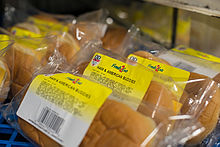
Sandwiches have been widely sold in cafes, railway stations, pubs and diners since the invention of sliced bread in the 1920s.[33] Sandwiches kept unwrapped, drying up and edges curling, until they were sold, were widely found in Britain until the 1970s. Cafes and buffets in railway stations and on trains were notorious, and the term "British Rail sandwich" was often used satirically.
In 1979, the British store chain Marks & Spencer introduced a small range of chilled, pre-made sandwiches sold in wedge-shaped boxes, sealed to keep them fresh.[33] As they proved popular, a small experiment involving five stores rapidly grew to cover more than one hundred stores. Within a year, the store was looking for ways to manufacture sandwiches at an industrial scale. By the end of the decade, the British sandwich industry had become worth £1bn.[34] In 2017, the British sandwich industry made and sold £8 billion worth of sandwiches.[34]
Gallery
-
Croque-monsieur, a French ham and cheese hot sandwich
-
Jambon-beurre, a French ham baguette sandwich
-
Porilainen, a Finnish burger-like sandwich
-
A Philadelphia-style cheesesteak, a type of submarine sandwich
-
Smoked meat sandwich
-
French breadsandwich with fries
-
Sandwich making
-
Grilled cheese sandwich
-
Shawarma sandwich
-
Doner sandwich
-
Chicken breastsandwich
-
An open sandwich with smoked horse meat in the Netherlands
-
Sausage, egg and cheese sandwich
-
Smoked salmon-and-cream-cheese sandwiches on pieces of baguette
-
Crustless English sandwiches on a plate
-
Sandwich filled with olives and sliced red tomatoes
-
Cross section of a sandwich
See also
- Butterbrot – Buttered bread, a German staple food
- Finger food
- Fuzzy concept § Sandwich example
- List of bread dishes
- List of sandwiches
- List of American sandwiches
- List of foods
- Panini (sandwich)
- Sandwich cake– Cake made from stacked layers of cake held together by filling
- Sándwich de miga – Sandwich popular in Argentina and Uruguay
- Soup and sandwich
- Tramezzino – Triangular Italian sandwich made with white bread and no crusts
- Vada pav – Indian fast food item
References
- ^ a b Abelson, Jenn (10 November 2006). "Arguments spread thick". The Boston Globe. Archived from the original on 7 December 2008. Retrieved 27 May 2009.
- ^ "sandwich". Merriam-Webster. Archived from the original on 2 November 2021. Retrieved 29 March 2012.
- ISBN 978-0-13-138022-6.
- ISBN 978-0-19-871205-3. Archivedfrom the original on 13 May 2023. Retrieved 19 March 2023.
- ^ "What is a Sandwich? | British Sandwich Week". British Sandwich & Food to Go Association. Archived from the original on 31 October 2023. Retrieved 18 May 2022.
The British Sandwich Association defines a sandwich as: Any form of bread with a filling, generally assembled cold – to include traditional wedge sandwiches, as well as filled rolls, baguettes, pitta, bloomers, wraps and bagels. [...] There is much debate as to what constitutes a sandwich but burgers and other associate products are not considered to be a sandwich.
- ISBN 978-0-13-138022-6.
- ISBN 1-883904-87-0.
- ^ a b c d e What's Cooking America Archived 29 April 2015 at the Wayback Machine, Sandwiches, History of Sandwiches. 2 February 2007.
- ^ a b c "Sandwich celebrates 250th anniversary of the sandwich". BBC News Online. 12 May 2012. Archived from the original on 29 December 2017. Retrieved 18 May 2012.
- ^ Marks, Kathy (17 May 1997). "BLT: British, lousy and tasteless". The Independent. London. Archived from the original on 10 June 2020. Retrieved 11 September 2017.
- ^ Bavli Pesachim 115a; See also Passover Hagadah
- ISBN 0-7190-5567-9.
- ^ Ray, John (1673). Observations topographical, moral, & physiological; made in a journey through part of the Low Countries, Germany, Italy, and France …. London, England: John Martyn. p. 51.
- The Embarrassment of Riches(1987:152).
- ^ Grosley, Londres (Neuchatel, 1770) and A Tour to London, or, New observations on England and its inhabitants, translated from the French by Thomas Nugent (London: Printed for Lockyer Davis) 1772; Hexmasters Faktoider: Sandwich Archived 19 February 2023 at the Wayback Machine: English quotes from Grosley 1772
- ^ a b Encyclopedia of Food and Culture, Solomon H. Katz, editor (Charles Scribner's Sons: New York) 2003
- ISBN 978-0199677337. Archivedfrom the original on 9 February 2024. Retrieved 15 December 2016.
- ^ The Oxford English Dictionary gives its first appearance as 1762.
- ^ White City Shopping Ctr., LP v. PR Rests., LLC, 21 Mass. L. Rep. 565 (Mass. Super. Ct. 2006)
- ISBN 978-84-283-2035-1. Retrieved 11 July 2010.
- ^ "Consultorio gastronómico". La Verdad Digital S.L. (in Spanish). Archived from the original on 27 August 2007. Retrieved 21 July 2010.
- ISBN 978-1-78607-270-2. Archivedfrom the original on 4 July 2023. Retrieved 6 February 2022.
...the British are so particular about sandwiches that they use the word less than Americans do. In Britain, a sandwich is some filing between two slices of bread. Not a roll. Not a bagel. Not a baguette. Without sliced bread, it's not a sandwich. The American sandwich prototype is much like the British: savoury filings within two slices of bread. But American sandwiches are allowed to wander further from the prototype because they interpret the 'bread' requirement more loosely. An American sandwich can be on a roll, on a bagel, on a bun, on a croissant, and at breakfast time, on an English muffin...
- ^ The Oxford English Dictionary[not specific enough to verify]
- ^ Taste Taste: Ice Cream Sandwiches, NYmag.com Archived 16 October 2010 at the Wayback Machine
- ^ Oreo Sandwich Biscuits, Nabiscoworld.com Archived 22 January 2013 at the Wayback Machine
- ^ "butty". Oxford English Dictionary (Online ed.). Oxford University Press. (Subscription or participating institution membership required.) English regional (chiefly northern). Originally: a slice of bread spread with butter. Now: a filled sandwich; (also) an open sandwich. Frequently with modifying word denoting the filling or topping.
- ^ "Butty". dictionary.com. Archived from the original on 28 November 2023. Retrieved 13 August 2019.
- ^ "Sarnie". dictionary.com. Archived from the original on 28 November 2023. Retrieved 13 August 2019.
- ^ "sanger". Oxford English Dictionary (Online ed.). Oxford University Press. (Subscription or participating institution membership required.)
- ^ "Parliamo Scots? – Food". Rampant Scotland. Archived from the original on 28 November 2023. Retrieved 28 November 2016.
- ^ ""sammich"". Archived from the original on 28 November 2023. Retrieved 8 April 2022.
- ^ Naylor, Tony (8 January 2020). "£14 for a sandwich? What are restaurants playing at?". The Guardian. Archived from the original on 28 November 2023. Retrieved 17 October 2022.
- ^ ISBN 978-1-86189-891-3. Archivedfrom the original on 25 April 2024. Retrieved 26 September 2020.
- ^ from the original on 4 December 2017. Retrieved 4 December 2017.

